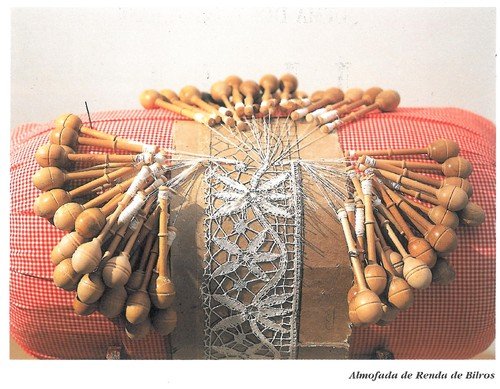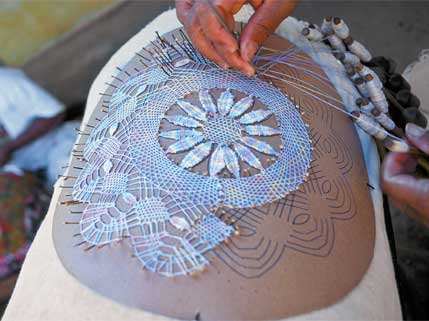Bobbin lace and embroidery: Techniques and Stories
Bobbin lace and embroidery are among the most traditional handicrafts in the Northeast of Brazil, especially in Ceará. Bobbin lace is not only a source of income, but also a form of entertainment and a link between the women who have marked the history of the Northeast and the Morros da Mariana.
This type of lace can be found on a variety of items such as clothing, scarves and towels, and plays an important economic role in the North, Northeast and South of Brazil.

Bobbin lace in the north-east

Cushion lace, also known as bobbin lace, is made by the skilful hands of lace makers. These artisans use a cushion, perforated cardboard, thread and bobbins (small wooden pieces similar to spindles).
This technique, brought by Portuguese and Azorean settlers, is a tradition that has taken root in various regions of the Brazilian coast.
The lace is made on a cushion filled with carnauba straw, on which a design is placed as a mould for the bobbin. For the embroidery, the lacemakers use pieces of wood glued to a coconut typical of the region, known as tucum.
The cardboard containing the designs is passed down from generation to generation, and many designs are unique to each family. Although lace is not originally a Brazilian product, it has become a local cultural expression through acculturation.
Lace made with a bobbin is known as “bobbin lace”. The bobbin is a small instrument with a short shaft and a spherical tip. A length of thread is attached to the other end, allowing the craftswoman to follow the design of the lace to be made.

This type of lace requires the use of several bobbins, the number of which varies according to the complexity of the design.
Bilro lace is worked on cushions placed on the lap of the weaver or on wooden trestles in front of her. The thread used is mainly cotton, usually in white, both for tradition and to make the patterns easier to see.
The designs are old and have been passed down from generation to generation. In order to create new designs, lacemakers often exchange piques with each other or obtain patterns from other places. Some rare lace makers have the ability to make lace from the head, without using a mould.
Bobbin lace can take many forms, including
- Nozzles or tips to decorate the edges of fabrics or to be placed between two pieces of fabric.
- Bedspreads, tablecloths, centrepieces and napkins.
- Lace in the shape of flowers, hearts, fans, etc. for fabric applications.
- Stilts: whole pieces used on the necklines of pullovers, blouses and dresses.
Difference between lace and embroidery
Bobbin lace and Embroidery are different forms of needlework, each with its own characteristics:
Bobbin lace
- Technique: Created using bobbins and a cushion, with the threads interwoven to form patterns.
- Materials: Cotton thread and bobbins, and a cushion stuffed with straw.
- Result: Pieces of lace with elaborate patterns used in clothing, towels and decorative items.
- Origin: It has historical roots in Europe, especially in Flanders and Italy.
Embroidery
- Technique: The process of applying decorative stitches to fabric using a needle and thread.
- Materials: Base fabric, embroidery thread and needle, using a variety of threads.
- Result: Embroidered designs on the surface of the fabric, decorating clothing and other items.
- Origin: An ancient practice that exists in different cultures around the world.
Lace and embroidery in Ceará
Lace and embroidery are predominant activities in Ceará, present in about 104 municipalities. Historical records indicate that this form of handicraft has existed in the state since colonisation, spreading throughout the interior and the coast, with a greater concentration in the municipalities of Aquiraz, Aracati, Beberibe, Acaraú and Trairi.
The development of handicrafts in the region has the potential to become a strong cultural brand, especially in the Prainha district of Aquiraz, where bobbin lace is an important handicraft activity.
With more than three centuries of history and an estimated population of 80,000, Aquiraz is a municipality that combines strong tourist appeal with a rich history of handicrafts, characteristics that are relevant to the local economy and cultural identity.
Origin of lace
The origin of bobbin lace is controversial, with different regions of Europe claiming it. Its creation dates back to the 15th and 16th centuries, with two main versions of its origin:
- Flanders (a region now divided between Belgium, France and the Netherlands) is considered one of the possible inventors of bobbin lace. Because of its complexity and beauty, the technique quickly spread throughout Europe, becoming a refined art and popular with the elite.
- Italy also claims to have created the technique and pioneered needlepoint, which gave rise to the famous Renaissance lace. This style spread with the development of bobbin lace in Europe, particularly in the Venice area.
The technique was brought to Brazil by the Portuguese and Azorean colonists and spread to various coastal regions, especially in the Northeast and South. In Brazil, bobbin lace was acculturated, adapted to local influences and became a traditional practice in various communities.
Publicações Relacionadas
Unveiling the Myth: Lampião and the Reality of Cangaço
History and Chronology of the Portuguese Tile Industry
June festivals: Tradition and Culture in the Northeast of Brazil
Graciliano Ramos: A Literary Icon of Brazilian Northeastern Life
Diógenes Rebouças and His Architectural Legacy
Biography of Victor Meirelles and analysis of the work "The First Mass in Brazil"
Brazil's historic moments illustrated in great works
History of Baroque Architecture in the Northeast and Minas Gerais
The origin of the Afro hairstyle in Salvador
Monte Santo in Bahia: History and Religious Tourism
History of the 8-bass accordion and its influence on forró
Candomblé in Bahia, Origin and Religiosity of the Bahian People
The 7 north-eastern rhythms and musical styles that enchant Brazil
The culture of Northeastern Brazil: how it originated, influenced and flourished
Rural Maracatu: A carnival tradition in the interior of Pernambuco
Musical styles, rhythms, singers and composers of northeastern Brazil
Bahia joins the ethnic tourism route
History and Chronology of the Carnival of Salvador de Bahia
This post is also on:
Português
English
Deutsch
Español
Français




















